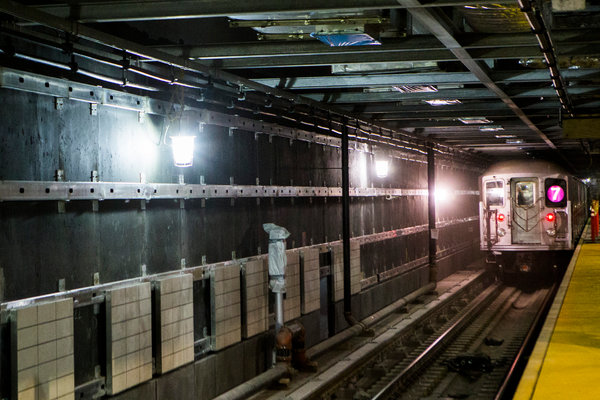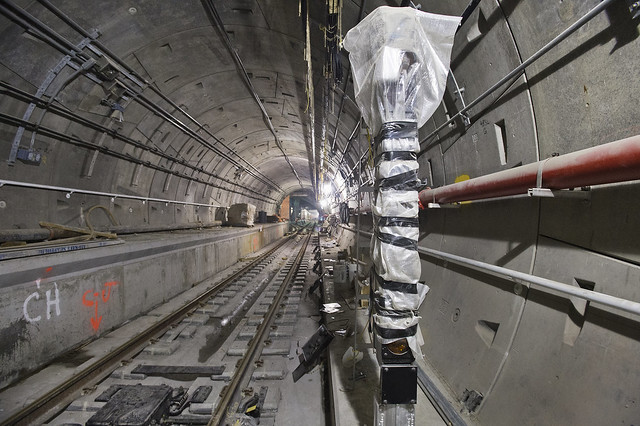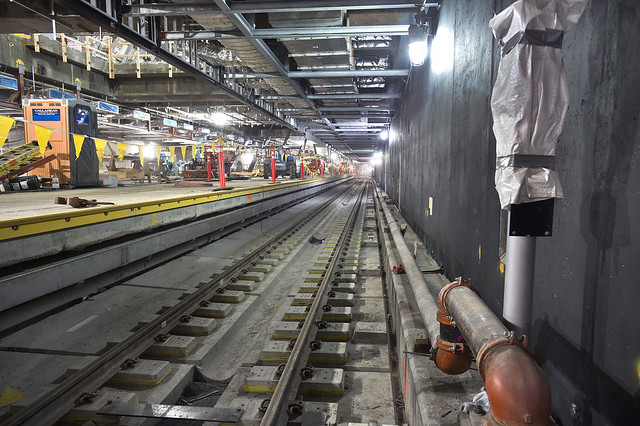News from December 2013
By Jennifer Fermino on Friday, December 20, 2013, 11:50 PM
http://assets.nydailynews.com/polopoly_fs/1.1554642.1387598655!/img/httpImage/image.jpg_gen/derivatives/article_970/7-train-extention-ride.jpg?enlarged
The 7 train arrives at the VIP-only opening of the 34th St. station Friday, and Mayor Bloomberg was there.
City planners project that 13,500 apartments and 24 million square feet of office space eventually will be added to the neighborhood, and that 27,000 people will use the new subway station — which will be named 34th St./Hudson Yards — every day.
The station will also sit near the northern terminus of the High Line, a former elevated rail line that has become a park and hugely popular tourist destination.
“Extending the No. 7 subway is the key to opening the west side for development,” said Michael Horodniceanu, president of MTA capital construction.
Also, more information on the subway station depth/construction techniques, etc. per the MTA press release.
Project is the First Subway Extension Funded by the City in More Than 60 Years
Press Release December 20, 2013 NYC Transit
Mayor Michael R. Bloomberg, MTA officials and other local leaders today took the first ride on the extension of the 7 Subway line, terminating at the new subway station located at 34th Street and Eleventh Avenue in Manhattan. The 7 Subway Extension is the first extension funded by the City in more than 60 years, and will provide New Yorkers and visitors with a link to Manhattan’s Far West Side, building on the area’s enormous progress in recent years.
The last extension financed by the City opened in December of 1950, when the Queens Boulevard line was extended to Jamaica-179th Street. This new extension demonstrates the commitment by the Bloomberg Administration to invest in infrastructure projects that will ensure New York City continues to be a leading global city in the future. The $2.4 billion project is scheduled to be completed in the summer 2014.
“Today’s historic ride is yet another symbol of how New York City has become a place where big projects can get done,” said Mayor Bloomberg. “This project is the linchpin of an ambitious transit-oriented, mixed-use development that is already transforming Manhattan’s Far West Side, and it demonstrates our Administration’s commitment over the past 12 years to invest in infrastructure that will allow our city to grow for generations to come.”
…As part of the redevelopment of Hudson Yards, a 45-block area on Manhattan’s Far West Side, the City of New York and the MTA worked together to extend the 7 Subway line farther west from its current terminus at Times Square to the new subway station at 34th Street and Eleventh Avenue. Once completed, the 7 Subway will be the only line south of 59th Street to provide service west of Ninth Avenue, offering access to the Jacob Javits Convention Center and introducing subway service and fostering transit-oriented development to the emerging, mixed-use community in Midtown West. Service will also improve for customers using the 7 Subway line in Queens and Manhattan as a result of the new station and additional tail tracks that extend to 26th Street to allow for the storage of more trains.
Construction of the extension began in December 2007. For the first time in New York City, tunnel boring machines (TBMs) were used to mine the subway tunnels. Two Herrenknecht manufactured TBMs burrowed 9,285 feet from Eleventh Avenue and 26th Street to Times Square. Local 147 NYC Sandhogs offered the Mayor the opportunity to name the TBMs and he chose to name them after his daughters, Emma and Georgina. As the tunnel boring machines mined, they placed pre-cast concrete lining rings along the excavated tunnel, making up the permanent liner of the finished tunnel.
Tunneling between 34th Street and Times Square presented unique challenges, as the subway will run under the existing Eighth Avenue Subway, Amtrak/NJ Transit tunnels, as well as tunnels to the former New York Central Line, the Lincoln Tunnel and the Port Authority Bus Terminal and ramps.
To create the new station cavern below 34th Street and Eleventh Avenue, the contractor used controlled drill-and-blast. Work will continue into next year to complete full signal and power installation.
…The new subway station at 34th Street and Eleventh Avenue will be ADA accessible, and will be the first station in the system to have two high-rise incline elevators that will provide access to riders between the upper mezzanine and lower mezzanine, which is 108 feet below street level. Four high-rise escalators will also be installed at the station.









